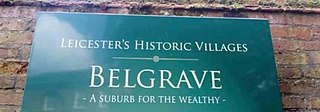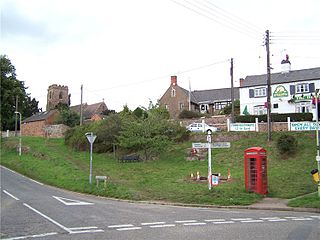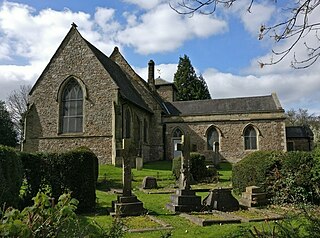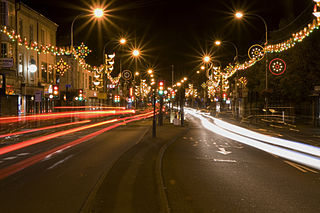
Leicester is a city, unitary authority area, unparished area and the county town of Leicestershire in the East Midlands of England. It is the largest city in the East Midlands with a population of 373,399 in 2022. The greater Leicester urban area had a population of 559,017 in 2021, making it the 11th most populous in England, and the 13th most populous in the United Kingdom. A 2023 report ranked Leicester 16th out of the 50 largest UK cities on a range of economic measures, and the first of seven East Midlands cities.

The Fosse Way was a Roman road built in Britain during the first and second centuries AD that linked Isca Dumnoniorum (Exeter) in the southwest and Lindum Colonia (Lincoln) to the northeast, via Lindinis (Ilchester), Aquae Sulis (Bath), Corinium (Cirencester), and Ratae Corieltauvorum (Leicester).

Blaby is a local government district in Leicestershire, England. The district is named after the village of Blaby, although the council is based in Narborough. The district covers an area lying south-west of the city of Leicester. Several of the district's settlements form part of the wider Leicester Urban Area, including Glenfield, where Leicestershire County Council has its headquarters at County Hall, and the town of Braunstone.

Belgrave is an area, suburb, electoral ward and administrative division of the city of Leicester, in the ceremonial county of Leicestershire, England. Belgrave is the location of and known for the National Space Centre, Space Park Leicester, the Golden Mile and Belgrave Hall.

Croft is a village and civil parish in the Blaby district of Leicestershire, off the Fosse Way, straddling the River Soar. The population of the civil parish at the 2011 census was 1,639.

Via Devana is the name given to a Roman Road in England that ran from Colchester in the south-east, through Cambridge in the interior, and on to Chester in the north-west. These were important Roman military centres and it is conjectured that the main reason the road was constructed was military rather than civilian. The Latin name for Chester is Deva and 'Via Devana' is thus 'The Chester Road'. Colchester was Colonia Victricensis, 'the City of Victory', and lays claim to be the oldest Roman city in Britain. The Via Devana had little civilian rationale and the road eventually fell into disuse as it was not possible to maintain extensive public works following withdrawal of the last Roman legion from Britain in 407. As a result, its route is difficult to find today, especially in its more northern reaches. It is omitted from some historians' maps for this reason but most nowadays accept its existence. The undocumented name Via Devana was coined by Charles Mason, D.D., of Trinity College, Cambridge, who was also rector of Orwell, Cambridgeshire, and Woodwardian Professor of Fossils at Cambridge University from 1734. During his life, Mason compiled a complete map of Cambridgeshire which was later published in 1808, long after his death.

Narborough is a large village and civil parish in the Blaby district of Leicestershire, England, around six miles southwest of Leicester. The population of the civil parish at the 2011 census was 8,498.

Leicester West is a constituency in Leicestershire that existed from 1918 to 1950, and recreated in 1974. The seat has been represented in the House of Commons of the Parliament of the United Kingdom by Liz Kendall of the Labour Party since 2010. Kendall currently serves as Secretary of State for Work and Pensions under the government of Keir Starmer. Since its creation in 1918, the seat has sided with parties from the left wing of politics.

South Wigston is a large village to the south of Leicester, England. It is outside the city boundary, forming part of the Oadby and Wigston district of Leicestershire. The population at the 2011 census was 7,490.

Braunstone is a town and civil parish in the district of Blaby in Leicestershire, England. At the 2011 census the population of the town was 16,850.

Enderby is a village and civil parish in Leicestershire, England, on the southwest outskirts of the city of Leicester. The parish includes the neighbourhood of St John's, which is east of the village separated from it by the M1 motorway. The 2011 Census recorded the parish's population as 6,314.

The Golden Mile is a name given to Belgrave Road, just north east of the city centre in Leicester, England. It is part of the ancient Roman Fosse Way and today is famed for its Indian restaurants, sari shops, jewellers, annual winter illuminations, and its internationally renowned annual Diwali celebrations, the largest of their kind outside of India.

Woodgate is an area in Leicester in Fosse Ward. It lies west of the River Soar and is an important entrance to the city leading on to Frog Island. Its western end lies at the 'Fiveways Junction, an intersection of Fosse Road North, Groby Road, Blackbird Road and Buckminster Road. To the south is the Rally Park, which was formerly the goods yard of the London Midland Railway, and originally the route of the Leicester to Swannington Railway built by Robert Stephenson in 1832. To the west is Fosse Road North. At its eastern end Woodgate terminates at the North Bridge over the old River Soar.

Thorpe Astley is a suburban settlement on the southwestern edge of the city of Leicester, England. It is part of the civil parish of Braunstone Town, although a small part of the development, around Goodheart Way, extends into Leicester Forest East civil parish. Both Braunstone Town and Leicester Forest East are within the district of Blaby, Leicestershire.
The Domesday manor of Bromkinsthorpe was situated outside the West Gate of Leicester, on the alluvial west bank of the River Soar. Its location is now covered by the area around Braunstone Gate, Leicester, and for much of the medieval period was a liberty within the parish of St Mary de Castro, Leicester, and hence, part of the Borough of Leicester.

Braunstone Park & Rowley Fields is an electoral ward and administrative division of the city of Leicester, England. It comprises the western Leicester suburbs of Braunstone Frith, Braunstone Park and Rowley Fields.

Aylestone Meadows is an 8.8-hectare (22-acre) Local Nature Reserve in Leicester, England, United Kingdom. It is owned and managed by Leicester City Council.
The following is a timeline of the history of the city of Leicester, the county town of Leicestershire, in England.

Narborough Road is a street in the British city of Leicester. A road since Roman times and one of the principal routes for Leicester to the M1 and M69 motorways, it is also a busy shopping street. In February 2016, it was named the UK's "most diverse" road in a research project by the London School of Economics (LSE).




















